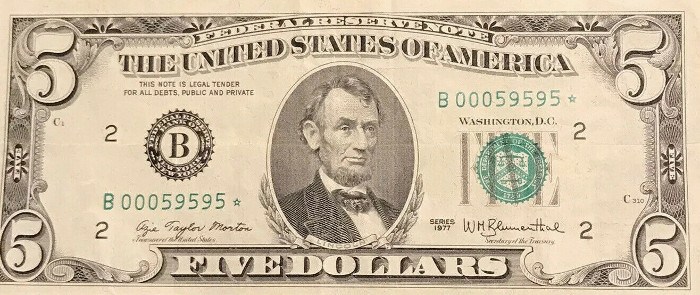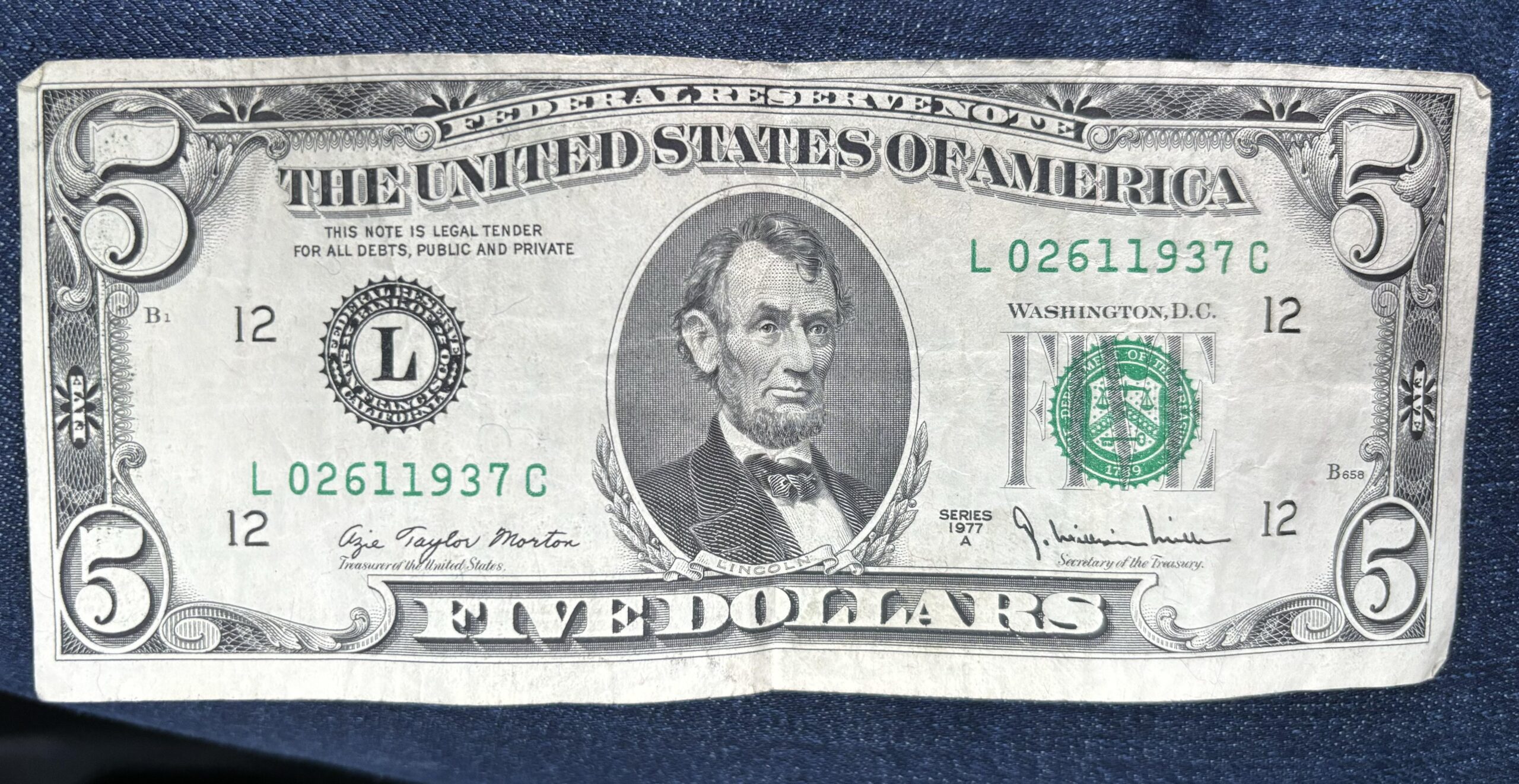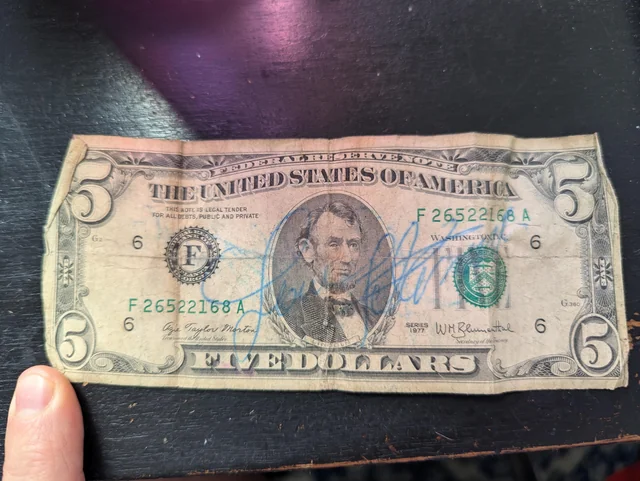When it comes to collecting currency, the value of a note can vary significantly depending on several factors such as its condition, rarity, and historical significance. The 1977 five dollar bill is no exception. In this article, we will dive deep into the value of the 1977 5 dollar bill, touching on factors such as its condition, series, star notes, and potential errors.
If you’re wondering “1977 5 dollar bill value?” or simply curious about the worth of your old $5 bills, keep reading to find out more.
Understanding The 1977 5 Dollar Bill
The 1977 $5 bill belongs to the Federal Reserve Note category. As part of the U.S. currency system, these bills were issued by the Federal Reserve and were widely circulated.

These bills were part of the series released in two different years: 1977 and 1977A. The main distinguishing feature of these bills is their historical context, reflecting the era of the late 1970s in America.
Specifications of the 1977 $5 Bill:
- Denomination: $5.00 USD
- Type: Federal Reserve Note
- Series: Two Series—1977 and 1977A
- Design: Featuring Abraham Lincoln on the front and the Lincoln Memorial on the back.
At first glance, most 1977 five dollar bills may not appear to be very valuable. In fact, for the majority of these notes, the value remains close to the bill’s face value, especially in circulated condition.
But as we will see, there are exceptions, and certain types of 1977 $5 bills can be worth more than their initial face value.
How Much Is a 1977 $5 Dollar Bill Worth Today?
If you’re asking “1977 5 dollar bill value?” you’re likely hoping to discover if your bill could be worth more than its original $5 face value. The answer depends on the condition of the bill and whether it is part of any special category like a star note or has a unique error.
As of now, most 1977 $5 bills in circulated condition are worth only slightly above their face value. However, these bills may still hold some level of historical interest, which can influence their market value. Specifically, the inflation rate from 1977 to today has significantly affected purchasing power.

For example, $5 in 1977 is roughly equivalent to $26.04 today, considering an average inflation rate of 3.5% per year.
This inflation leads to a cumulative price increase of around 420.8%, making older bills more historically interesting, but not necessarily drastically more valuable unless they are in excellent condition or fall under certain categories.
1977 $5 Bill Value Based on Condition
The value of a 1977 five dollar bill is heavily influenced by its condition. Most notes that have been in circulation for a long time will show signs of wear, such as creases, folds, and minor staining. The grading system used by currency collectors is vital in determining how much a particular note is worth.
Very Fine Condition:
A 1977 $5 bill in very fine condition still retains its crispness and most of its original features. It may have minor creases or folds, but overall it’s in relatively good shape. The value of a 1977 $5 bill in very fine condition can range from $6 to $7.
Uncirculated Condition (MS 63 Grade):
Notes in uncirculated condition, meaning they have never been used in daily transactions and remain in perfect or near-perfect shape, can fetch a significantly higher price. A 1977 $5 bill graded as MS 63 (Choice Uncirculated) can be worth anywhere from $12.50 to $15, depending on the specific note and other factors.
Star Notes and Their Impact on Value
One of the most important variations within the 1977 series is the presence of star notes. These are replacement bills issued by the U.S. Federal Reserve to replace damaged or misprinted notes during the production process. Star notes are rare and thus command a higher value in the market, especially when compared to standard 1977 $5 bills.
A star note is easy to identify—just look for a star symbol at the end of the serial number. This star symbol indicates that the bill is a replacement note, making it more collectible and valuable to enthusiasts.
1977 Series Star Notes:
For the 1977 series, star notes in very fine condition can be worth between $10 and $12.50. If the note is in uncirculated condition with a grade of MS 63, it may sell for around $40 to $50. However, star notes from certain Federal Reserve Banks—such as Boston, Dallas, and St. Louis—can fetch even higher prices.
1977A Series Star Notes:
The 1977A $5 star notes tend to be even more valuable. In very fine condition, these notes are worth about $15 to $20, while uncirculated notes with an MS 63 grade can range from $32.50 to $45.
Certain star notes issued from Federal Reserve Banks like Boston, Minneapolis, and Richmond can be even more valuable, making them highly sought after by collectors.
Error Notes and Their Rarity
Another factor that could influence the value of your 1977 $5 bill is the possibility of errors during production. Errors in printing are relatively rare but can make a note much more valuable if identified and authenticated. These errors could include misprints, off-center printing, or other noticeable flaws.
Error notes can command prices far beyond typical 1977 $5 bills. If you suspect your bill has an error, it’s worth consulting a professional currency dealer to have it inspected and possibly graded.
1977 $5 Bill vs. Other Series Bills
When evaluating the value of a 1977 five dollar bill, it’s important to compare it to other series bills. For instance, the 1963 $5 bill, which is also a popular collectible note, generally holds a higher value due to its age and rarity compared to the 1977 $5 bills.
However, when it comes to modern bills, the 1977 $5 bill has a reasonable level of historical interest, particularly when star notes or error notes are involved.
In comparison, bills from the 1990s or early 2000s are less likely to carry much added value unless they too are part of unique categories like star notes or errors.
Grading System for Currency Notes
As previously mentioned, the grading of a currency note plays a major role in determining its value. In general, currency notes are graded using a scale from 1 to 70, with 70 being perfect. The grades used for the 1977 $5 bill are as follows:
Very Fine (VF): A note that has seen some use but is still in good condition. There may be minor folds or creases, but it’s still legible and well-preserved.
Choice Uncirculated (MS 63): A note that appears to have never been in circulation, or is in nearly pristine condition. These bills are very valuable and are highly desirable among collectors.
Conclusion: 1977 5 Dollar Bill Value
Most 1977 5 dollar bills are not worth much more than their face value, especially when they are in circulated condition. However, star notes and error notes can significantly increase the worth of these bills, especially if they are in uncirculated condition.
If you have a 1977 $5 bill, it’s important to carefully check for star notes or other rare features that might make your bill more valuable.
For collectors and currency enthusiasts asking the question “1977 5 dollar bill value?” the answer ultimately depends on the bill’s specific features, such as its condition. Keep in mind that five dollar bills from the 1977 series are a common sight, but a rare star note or error could be worth much more than $5.
The 1977 $5 bill is a fascinating piece of U.S. history. Whether it’s a standard issue or a rare note, the 1977 5 dollar bill can hold a certain charm and value for collectors. Make sure to keep an eye on its condition and any special features, as they may increase the bill’s worth over time.

